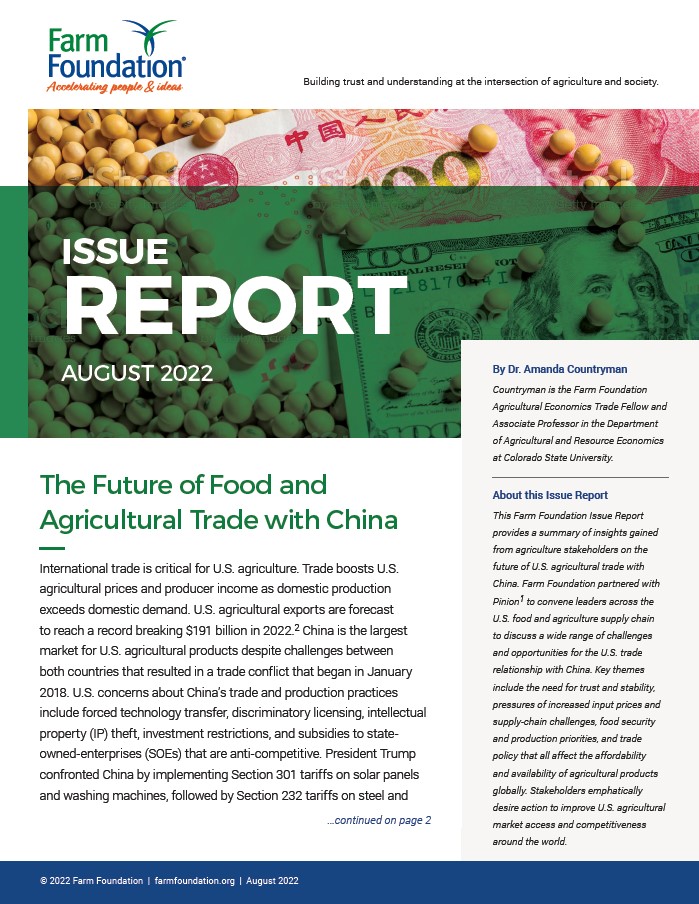Blog
The Future of Food and Agricultural Trade with China
This is an excerpt from the Farm Foundation Issue Report, The Future of Food and Agricultural Trade with China, by Dr. Amanda Countryman. The full Issue Report provides a summary of insights gained from agriculture stakeholders on the future of U.S. agricultural trade with China. Farm Foundation partnered with Pinion to convene leaders across the U.S. food and agriculture supply chain to discuss a wide range of challenges and opportunities for the U.S. trade relationship with China. Key themes include the need for trust and stability, pressures of increased input prices and supply-chain challenges, food security and production priorities, and trade policy that all affect the affordability and availability of agricultural products globally. Stakeholders emphatically desire action to improve U.S. agricultural market access and competitiveness around the world.
International trade is critical for U.S. agriculture. Trade boosts U.S. agricultural prices and producer income as domestic production exceeds domestic demand. U.S. agricultural exports are forecast to reach a record breaking $191 billion in 2022. China is the largest market for U.S. agricultural products despite challenges between both countries that resulted in a trade conflict that began in January 2018. U.S. concerns about China’s trade and production practices include forced technology transfer, discriminatory licensing, intellectual property (IP) theft, investment restrictions, and subsidies to state owned enterprises (SOEs) that are anti-competitive. President Trump confronted China by implementing Section 301 tariffs on solar panels and washing machines, followed by Section 232 tariffs on steel and aluminum imports. China responded by imposing retaliatory tariffs on $3 billion of U.S. goods, including agricultural products. This prompted additional trade actions in a tit-for-tat battle for two years before the U.S. and China reached the Phase One agreement. The agreement pledged increased Chinese purchases of U.S. agriculture, manufacturing, and energy products, and addressed sanitary and phytosanitary barriers on U.S. exports of agricultural products, among other economic provisions.
U.S. agricultural exports to China totaled $35.9 billion in 2021, dominated by soybean exports, followed by corn, forest products, and various crop and meat products described in Figures 1 and 2. While the agreement halted further escalation in the trade conflict and showed promise for improved relations, import tariffs of approximately twenty percent on about sixty percent of bilateral trade between the two countries remain. Furthermore, the two-year timeline for Phase One purchases by China concluded in December 2021, with no signs of a new trade agreement between the two countries.
Given the uncertainty of economic relations with China and the importance of the Chinese market for U.S agriculture, Farm Foundation and Pinion convened agricultural industry leaders in five locations to learn what their perspectives are on the future of the U.S. trade relationship with China. Discussions were held in Minneapolis, Chicago, Houston, Sacramento, and Seattle, representing diverse U.S. agricultural stakeholders (see Figure 3). Tremendous insights were gained during conversations across the locations that gave rise to four key themes encompassing challenges and opportunities for the future of trade with China. Themes discussed in detail in this report include 1) trust and stability, 2) input costs and supply chain logistics, 3) food security and production priorities, and 4) trade policy. Engagement with agricultural industry leaders revealed optimism despite uncertainty and a universal desire for action to facilitate productive trade with China and beyond.

